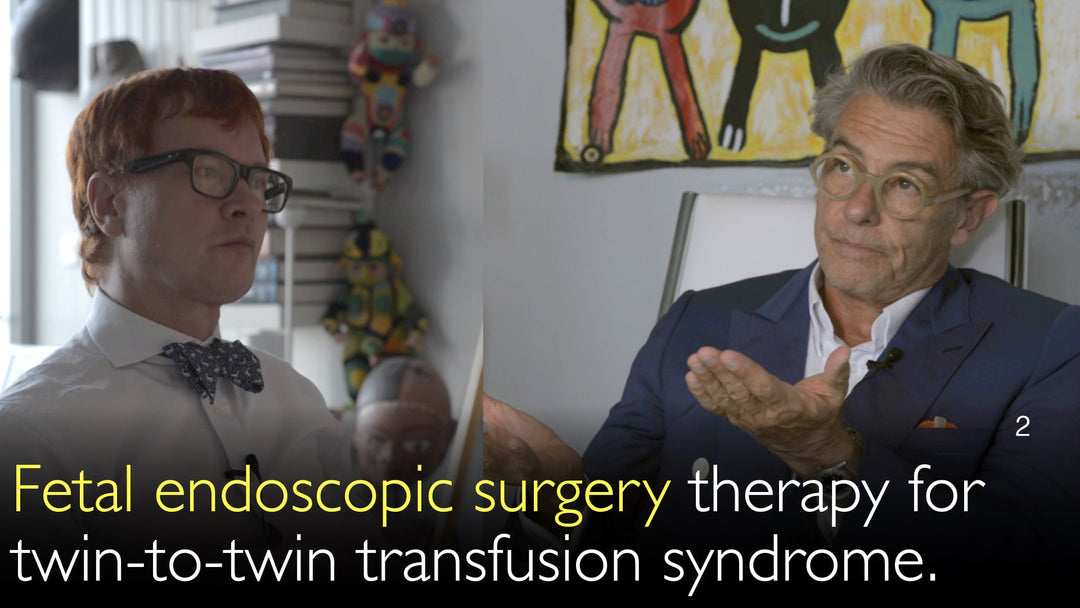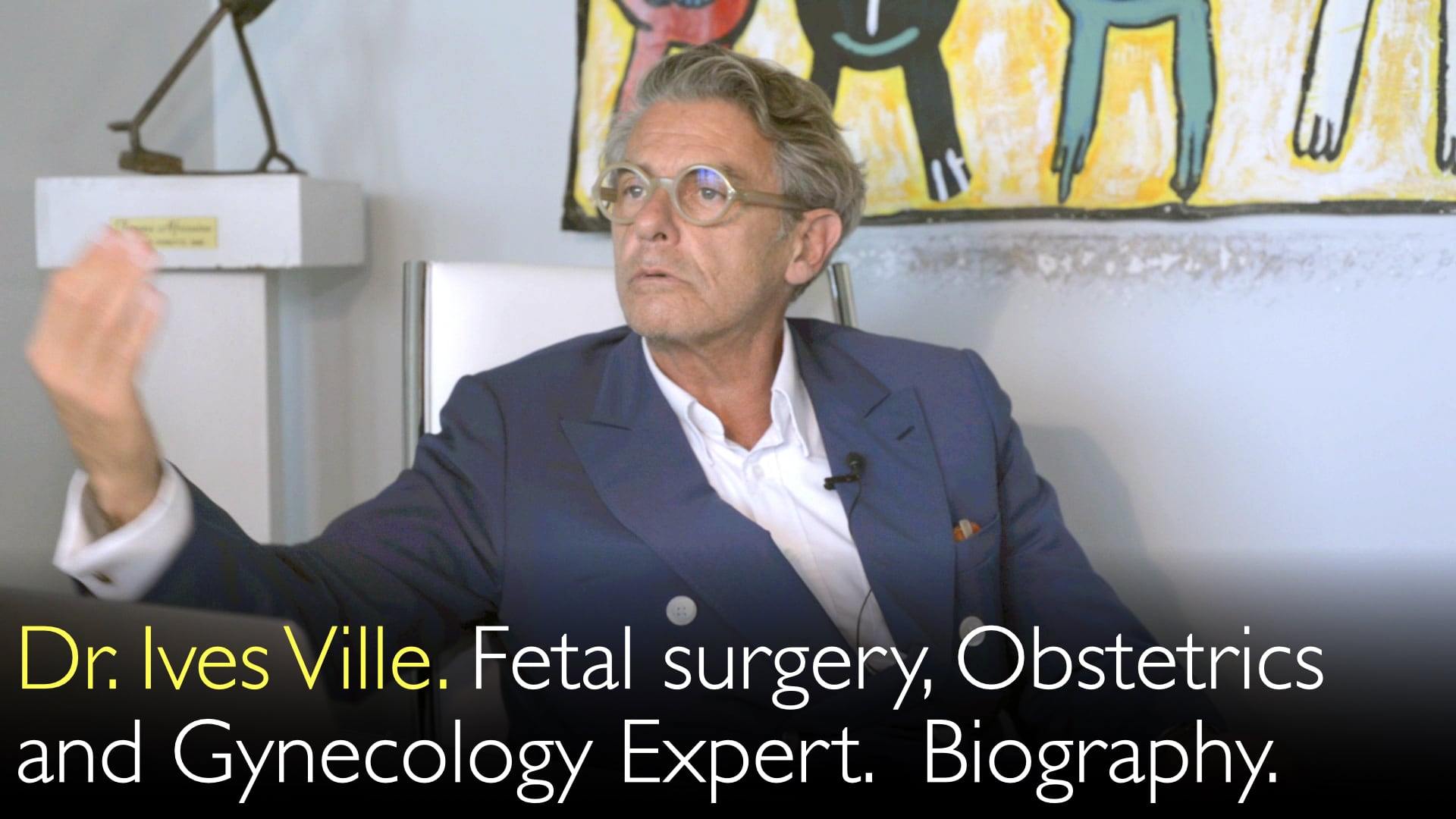Fetaalilääketieteen ja monimutkaisten raskauksien johtava asiantuntija, lääketieteen tohtori Yves Ville, kertoo endoskooppisen laserleikkauksen käytöstä kaksosten välisen verensiirto-oireyhtymän hoidossa. Toimenpiteessä kohdennetaan poikkeavia istukkaverisuonia tasoittaen kaksosten välistä epätasaista verenkiertoa. Tohtori Ville mainitsee korkeat onnistumisprosentit: molempien kaksosten selviytymismahdollisuus on 75 %, ja vähintään toisen kaksosen selviytymismahdollisuus 90 %. Hän nostaa esiin myös ennenaikaisen synnytyksen merkittävimmän riskin, joka keskimäärin tapahtuu noin 33.–34. raskausviikolla.
Endoskooppinen lasersähkökirurgia kaksoskudosten verensiirtosyndroomaan (TTTS)
Hyppää osioon
- TTTS-hoidon yleiskatsaus
- Lasersähkökirurginen tekniikka
- Erikoislääkärin löytäminen
- TTTS-leikkauksen tulokset
- Ennenaikaisuuden riskit
- Optimaalinen synnytysaika
- Koko tekstitys
TTTS-hoidon yleiskatsaus
Endoskooppinen lasersähkökirurgia on vakiintunut hoitomuoto kaksoskudosten verensiirtosyndroomaan. Alan uranuurtaja, lääketieteen tohtori Yves Ville, korostaa, että toimenpide kohdistuu suoraan TTTS:n juurisyihin. Sairaus ilmenee, kun identtiset kaksoset jakavat istukan, mutta verenkierto on epätasapainossa: toinen saa liikaa verta, toinen liian vähän. Leikkauksessa käytetään fetoskooppia ongelmallisten verisuonten visualisointiin ja hoitoon istukan pinnalla.
Lasersähkökirurginen tekniikka
TTTS-leikkaus on nykyään hyvin toistettava. Lääketieteen tohtori Yves Ville painottaa, että kriittisin vaihe on kohdun oikeaoppinen avaaminen leikkauskentän paljastamiseksi. Itse leikkaus koostuu poikkeavien yhdistävien verisuonten koaguloinnista istukassa. Tohtori Ville huomauttaa, että tämä ei vaadi poikkeuksellista kirurgista taitoa, vaan ennen kaikkea huolellisuutta ja perusteellisuutta. Tavoitteena on tunnistaa ja lasertaa kaikki kaksosten välisen epätasaisen verenkierron aiheuttavat verisuonet.
Erikoislääkärin löytäminen
Pääsy TTTS-asiantuntijahoitoon on parantunut merkittävästi. Lääketieteen tohtori Yves Ville toteaa, että endoskooppista sikiökirurgiaa harjoitetaan nykyään monissa arvostetuissa keskuksissa kehittyneissä maissa. Tämä on ratkaisevan tärkeää, koska syndroomaan sairastuneet naiset eivät usein pysty matkustamaan pitkiä matkoja mukavasti. Toimenpide, joka suoritettiin ensimmäisen kerran vuonna 1991, on 30 vuoden menestystarina. Lääketieteen tohtori Anton Titov korostaa, että potilaiden on tärkeää tietää hoidosta, jotta he voivat löytää sopivan erikoistuneen lääkärin läheltään.
TTTS-leikkauksen tulokset
TTTS-leikkauksen tulokset ovat vakiintuneet ja erittäin myönteisiä. Lääketieteen tohtori Yves Ville esittää selviä selviytymistilastoja: molempien kaksosten selviytymismahdollisuus on 75 %, ja vähintään toisen kaksosen selviytymisprosentti on 90 %. Tämä tarkoittaa, että riski menettää toinen kaksosista on noin 15 %, ja molempien menettämisen riski noin 5 %. Kriittisesti tohtori Ville vahvistaa, että jos molemmat kaksoset selviävät, heidän hermostollinen kehityksensä on tyypillisesti täysin normaalia.
Ennenaikaisuuden riskit
TTTS-leikkauksen pääasiallinen riski on ennenaikainen vesikalvon puhkeaminen (engl. preterm premature rupture of membranes, PPROM). Lääketieteen tohtori Yves Ville selittää, että tämä johtuu siitä, että kirurgisten instrumenttien on mentävä heikkojen vesikalvojen läpi. Tämä komplikaatio esiintyy noin 20 %:ssa tapauksista. Vaikka kaikki PPROM-tapaukset eivät johda välittömään synnytykseen, se on merkittävä huolenaihe. Keskimääräinen synnytysikä tämän sikiökirurgian jälkeen on 33 viikkoa. Tästä ennenaikaisuudesta tulee päähaaste TTTS:n onnistuneen hoidon jälkeen.
Optimaalinen synnytysaika
Synnytyksen ajoituksen suunnittelu on keskeinen osa leikkauksen jälkeistä hoitoa. Tohtori Ville neuvoo, että synnytys tapahtuu tyypillisesti noin 34–35 viikon raskausiässä. Tämä on tarkoituksenmukainen strategia myöhäisten onnettomuuksien, kuten kohdunulkoisen kuoleman tai istukan irtoamisen, estämiseksi, jotka voivat ilmetä istukkaan kohdistuneen leikkauksen jälkeen. Lääketieteen tohtori Anton Titov käsittelee tätä ajoitusta standardikaksosraskauksien kontekstissa, joille suositellaan nykyään synnytystä viimeistään 37 viikon iässä. Synnytys 35 viikolla on turvallinen ja suunniteltu lopputulos lapsille, jotka ovat käyneet läpi tämän hengenpelastavan toimenpiteen.
Koko tekstitys
Lääketieteen tohtori Anton Titov: Olet jo maininnut asiaa, mutta anna minun kysyä tarkemmin. Olet erikoistunut syntymättömien lasten ja monimutkaisten raskauksien hoitoon, kuten mainitsit. Erityinen komplikaatio on raskaus, jossa kaksi sikiötä jakaa verenkierron, mutta se on epätasainen. Tämä johtaa yliravitsemukseen ja veren liikakierron toisessa sikiössä sekä aliravitsemukseen toisessa.
Kuten mainitsit, käytät endoskooppista lasersähkökirurgiaa kaksoskudosten verensiirtosyndrooman hoitoon. Et leikkaa sikiötä vaan itse istukkaa. Voisitko tiiviimmin kuvata, miten lähestyt kaksoskudosten verensiirtosyndroomaa? Miten potilaat ehkä löytävät sinut näissä tilanteissa? Eivät kaikki, joilla on nämä diagnoosit, luultavasti pääse asiantuntijan luokse.
Siitä huolimatta minusta on tärkeää, että ihmiset tietävät, miten se tehdään, jotta he voivat löytää sopivan asiantuntijan.
Lääketieteen tohtori Yves Ville: Kaksoskudosten verensiirtosyndrooman leikkaus on nyt toistettavissa useissa keskuksissa. Mielestäni siitä voimme olla ylpeitä: olemme suunnitelleet tekniikan, jota eri henkilöt käyttävät samalla menestyksellä. Se ei ole jotain, mitä aloittaa yhdessä yössä, mutta kun olet tehnyt noin 50 tapausta ja sovellat oikeaa strategiaa, kohdun avaaminen on tärkein vaihe.
Paljastat leikkauskentän oikein; sitten leikkaus ei ole vaikea, koska se on vain verisuonten koaguloimista. Se ei vaadi kirurgin taitoa; kyse on oikeaan paikkaan pääsemisestä. Jos pystyt siihen, olet tarpeeksi huolellinen ja perusteellinen poikkeavien verisuonten etsinnässä, tämä leikkaus voidaan tehdä monessa paikassa.
Lisäksi nämä naiset ovat sairastuneet tähän syndroomaan; he eivät pysty matkustamaan kovin helposti. Joten jos lähellä on arvostettu keskus – ja nykyään kaikissa kehittyneissä maissa on henkilöitä, jotka tekevät endoskooppista sikiökirurgiaa – se on parempi kuin pitkien matkojen matkustaminen, koska se ei ole heille mukavaa.
Tämä sikiöendoskooppinen kirurgia tehtiin ensimmäisen kerran vuonna 1991. Joten on ollut 30 vuotta aikaa arvioida sen menestystä ja toistettavuutta. Mielestäni se on nyt standardihoito.
Lääketieteen tohtori Anton Titov: Miten tulokset ovat? Yleensä, mikä on odotettu kliininen lopputulos kaksoskudosten verensiirtosyndroomalle?
Lääketieteen tohtori Yves Ville: Ihmiset voivat odottaa 75 %:n selviytymistä molemmille kaksosille ja 90 %:n selviytymistä vähintään toiselle kaksoselle. Joten riski menettää toinen on noin 15 %:ssa tapauksista ja molemmat noin 5 %, suunnilleen. Jos molemmat kaksoset selviävät, kehitys on muuten normaalia; se on täysin normaalia.
Lääketieteen tohtori Anton Titov: Joo, riippuen siitä, millä raskausiällä he synnytetään, mutta sitten ongelma on ennenaikaisuus. Se ei ole enää kaksoskudosten verensiirtosyndrooma. Onko yleistä, että ennenaikaisuus vaikuttaa sikiöön leikkauksen jälkeen?
Lääketieteen tohtori Yves Ville: Joo, yksi sikiökirurgian – endoskooppisen sikiökirurgian ja avoimen sikiökirurgian, mutta emme tee sitä – Akilleenkantapäistä on kalvon puhkeaminen, koska instrumenttien on mentävä näiden kalvojen läpi. Kalvot ovat herkkiä; kalvon puhkeaminen leikkauksen jälkeisinä viikkoina on hyvin yleistä. Se on noin 20 %. Jotkut niistä päättyvät ennenaikaiseen synnytykseen; jotkut eivät, koska se on vain mekaanista.
Sen jälkeen, eivät kaikki naiset synnytä hyvin ennenaikaisesti, mutta keskimäärin naiset synnyttävät 33 viikolla. Joka tapauksessa emme mene yli 34 viikkoa, koska kun olet leikannut istukkaa, olet todennäköisesti sammuttanut osan istukan toiminnasta myös.
Aluksi, vuosia sitten, havaitsimme joitain myöhäisiä onnettomuuksia, kuten kohdunulkoisen kuoleman tai istukan irtoamisen, ja ajattelimme, että voisimme olla varovaisempia ja synnyttää nämä lapset hieman aiemmin. Joten keskimäärin 34–35 viikolla mielestämme on oikea aika synnyttää lapsi sikiökirurgian jälkeen.
Mutta siitä lähtien asiat ovat edenneet jopa normaaleissa kaksosraskauksissa. On nyt vakiintunutta, että kaksosia ei pitäisi synnyttää myöhemmin kuin 37 viikolla. Joten jos synnytät heidät 35 viikolla, sen jälkeen mitä he ovat käyneet läpi syndrooman kanssa, en usko, että se on ongelmasi.





